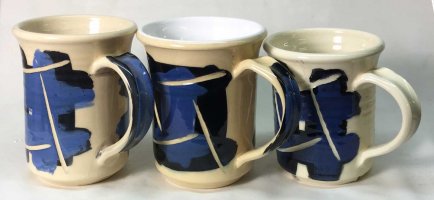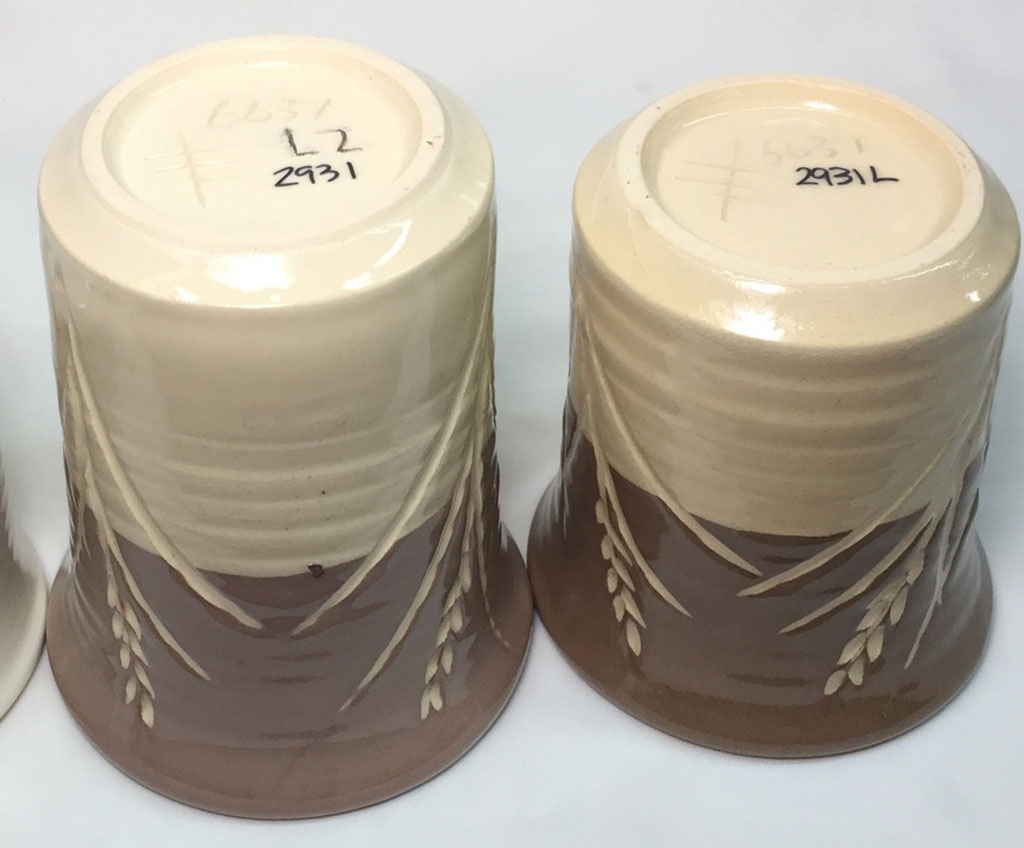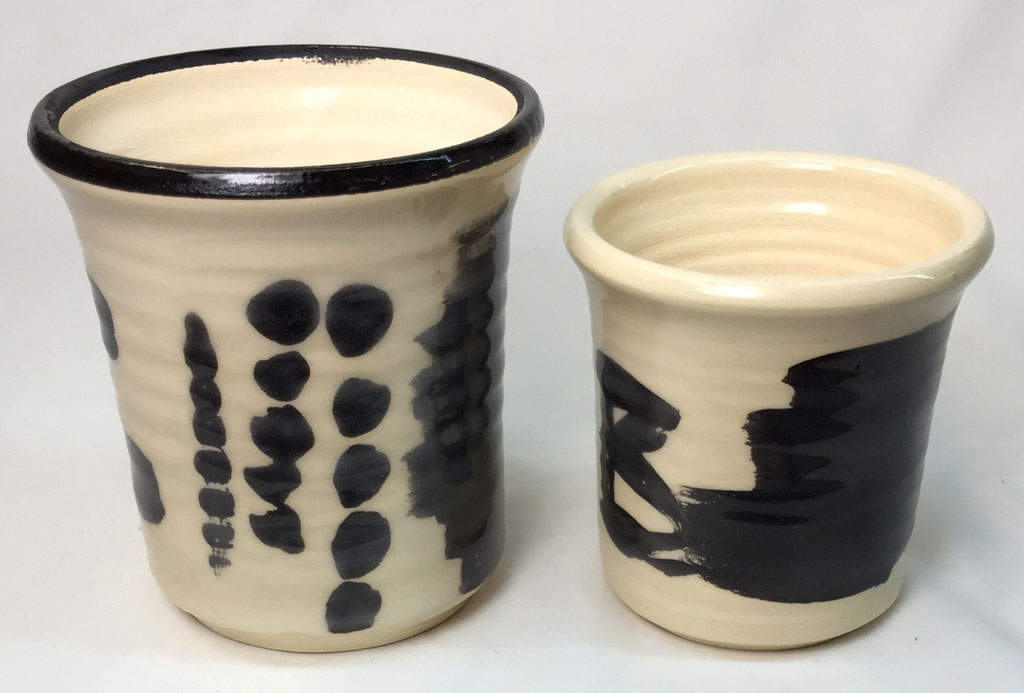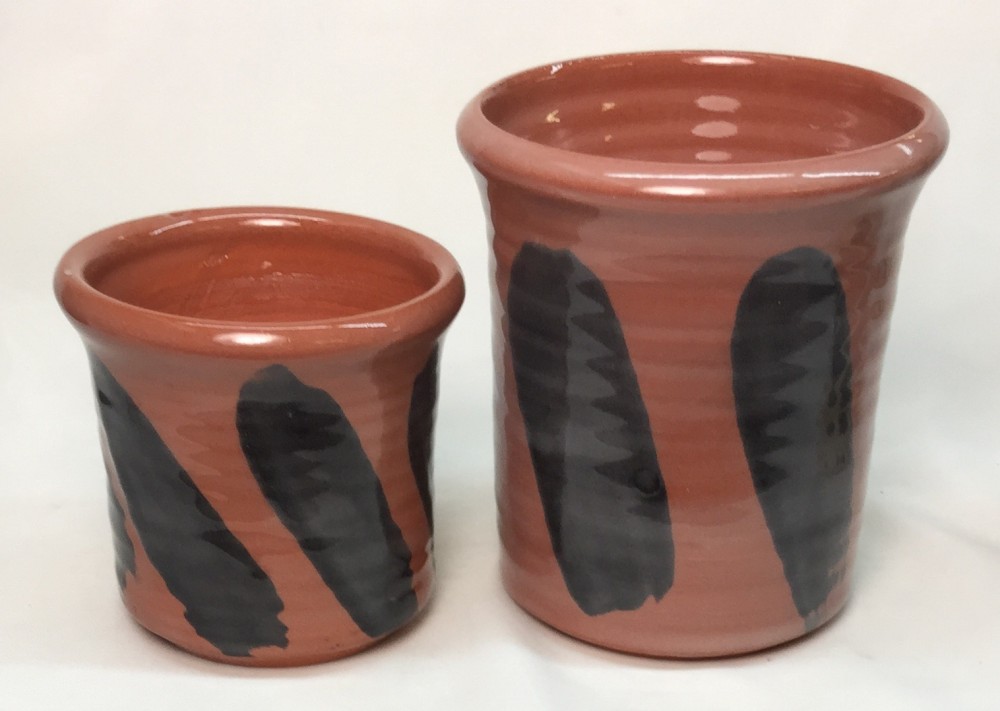Zero3 L Low Expansion Variant
|
Code # G2931L |
| Materials | Amt | Units | |
|---|---|---|---|
| Ferro Frit 3195 | 19.000 | KG | 19.10% |
| EPK | 10.000 | KG | 10.05% |
| Ferro Frit 3249 | 19.000 | KG | 19.10% |
| Fusion Frit F-524 | 49.000 | KG | 49.25% |
| Zinc Oxide | 2.500 | KG | 2.51% |
Total:99,500.00 (R)
Auto Unity Formula
|
Si:Al: 6.4:1 6.3 (Molar:6.0) 1.5 Cost 1.95 per kg |
Notes
This is a low-expansion version of the Zero3 Clear glaze (code G2931K), originally developed from the Worthington Clear Gerstley Borate based recipe. While G2931K fits the vitreous Zero3 porcelain and non-vitreous bodies containing talc (like Plainsman L212, L215), it crazes on others (e.g. Plainsman TerraStone, BuffStone, L210). This version drops its expansion drastically, from 7.4 down to 6.3 (by adding ZnO, ZrO and increasing MgO and SiO2).
Since the thermal expansion of this is higher than the original Wothington Clear and the L version is lower, it is thus possible adjust thermal expansion of either recipe by adding some of the other (to deal with shivering or crazing on almost any low fire body).
Do not try to use this with too little water. Mix it to 1.43 specific gravity and add vinegar or Epsom salts to gel it so that it stops moving (after vigorous stirring) in 2 or 3 seconds. When mixed right it applies very well to low or high porosity bisque (in a very thin layer if needed), it does not drip or move.
The hold:slow-drop firing schedule, like 04DSDH, is critical to a defect-free surface.
Pictures
G2931L and K clear glazes (for non-talc, talc bodies)

These pieces have underglaze decoration with a covering clear glaze. But the glazes are different. The G2931L (left) has a lower thermal expansion (to prevent crazing on non-talc bodies like this). The G2931K glaze fits the terra cotta because the latter contains significant talc (to raise its expansion to fit commercial glazes better). If you switched these glazes the left mug would craze the glaze and the right would would shiver it off in flakes.
Three low fire bodies that need three clear glazes

Because of glaze fit. Left: Plainsman Buffstone, contains no talc, fires buff. Center: L212 (about 25% talc). Right: L213 (about 45% talc, fires whiter). Talc raises thermal expansion. The centre glaze is G2931K (Insight-live reports COE 7.4), it fits L215 (also Zero3 porcelain and stoneware). It crazes on Buffstone and shivers on L213 and L212. G2931L has lower expansion (to work on zero-talc porous bodies). G2931H is higher (for talc bodies like L213).
G2931L2 and L on L212 at cone 04

The L2 is a beautiful transparent (even though it is applied quite thickly). The L2 has no micro-bubbles while the L does. The L2 is thicker. Neither are crazing after two days out of the kiln. L2 is still OK after two years.
L on F100 after 1 year - no crazing, cone 03

Also very strong and difficult to break
G2931L on Buffstone - Crazing after one year

L212 with G2931L glaze

1 year old. So crazing starting on the bottom.
Typecodes
ST-Untitled typecode
Alternate Code Number:GS04-1
XML (to paste into Insight)
<?xml version="1.0"?> <recipes version="1.0" encoding="UTF-8"> <recipe name="Zero3 L Low Expansion Variant" id="116168" key="RF6W4DKf" date="2020-12-02" typecodes="ST" codenum="G2931L" picturebasename=""> <recipelines> <recipeline material="Ferro Frit 3195" amount="19.000" tolerance="" unitabbr="KG"/> <recipeline material="EPK" amount="10.000" tolerance="" unitabbr="KG"/> <recipeline material="Ferro Frit 3249" amount="19.000" tolerance="" unitabbr="KG"/> <recipeline material="Fusion Frit F-524" amount="49.000" tolerance="" unitabbr="KG"/> <recipeline material="Zinc Oxide" amount="2.500" unitabbr="KG"/> </recipelines> </recipe> </recipes>
Born: 2006-03-16, Modified: 2020-12-02 07:29:04
Zero3 L Low Expansion w/F-69
|
Code # G2931L2 |
| Materials | Amt | Units | |
|---|---|---|---|
| Ferro Frit 3195 | 21.500 | KG | 21.50% |
| EPK | 10.000 | KG | 10.00% |
| Fusion Frit f-69 | 18.000 | KG | 18.00% |
| Fusion Frit F-524 | 48.000 | KG | 48.00% |
| Zinc Oxide | 2.500 | KG | 2.50% |
Total:100,000.00 (R)
Auto Unity Formula
|
Si:Al: 6.5:1 6.3 (Molar:6.0) 1.5 Cost 1.90 per kg |
Notes
Sample mix:
492 powder
73g Laguna gum solution (6.7g/100ml)
238 water
SG is 1.57
Paintability is good, but drying a little fast.
Added 30g more gum (which took SG to 1.52), it is better but still goes on too thick. It appears to need a specific gravity of 1.5 (turns out to be 54% powder, 46% water).
This is craze free on Buffstone for a few days after which some lines appear.
To prevent delayed crazing we are bisquing to cone 03 (and glaze firing lower e.g. cone 06-05).
Pictures
G2931L2 and L on L212 at cone 04

The L2 is a beautiful transparent (even though it is applied quite thickly). The L2 has no micro-bubbles while the L does. The L2 is thicker. Neither are crazing after two days out of the kiln. L2 is still OK after two years.
G2931L2 survives 300F:Icewater test on F100

Icewater was only put inside. It was stirred constantly to stay cold.
G3857B underglaze on Buffstone

Left one was bisque fired, right one was dry.
Both have two coats of G2931L2 clear glaze, brushed on.
Buffstone with G3857 underglaze

Left: Bisqued on G3857 black underglaze. Left half is covered with G2931L2 (dipped), right half is Amaco LG10 (painted). The latter is more transparent, but likely because it is thinner and coverage was much better (the dip shed off the black (yet healed amazingly well). The LG10 is crazing. Its intensity and clarity over the black is fantastic. The L2 is not crazed (even though it is thicker) and it healed the poor application.
Right: Under and overglazed leather hard. L2 left, LG10 right. LG10 covered well (although crazed) but it crawled (pulled away) some parts of the black underglaze (shown here), it was OK of the other black strokes. The L2 was painted, it is much thicker (not crazed). It pulled the black off in a couple of spots, but only a little.
G2931L2 on L215 bisqued and dary

Clear glaze is on pretty thick, clouding somewhat.
G2931L2 clear on buffstone bisque, unbisqed cups

Clouding happens for both, is applied too thick.
Various clear glazes on L215 P6654 Cone 04

Left to right: Crystanthos SG213, L2, Amaco LG-10.
The L2 is on thinner in the mug (thicker and clouding on the front)
They are fit (no crazing or shivering).
Not shown is Spectrum 06 Clear. It shivered badly and clouded.
Typecodes
ST-Untitled typecode
Alternate Code Number:GS04-1
Testdata
LDW - LOI/Density/Water Content
| WWGT | H2O | LOI | DENS | |
| 1 | 10.62 |
XML (to paste into Insight)
<?xml version="1.0"?> <recipes version="1.0" encoding="UTF-8"> <recipe name="Zero3 L Low Expansion w/F-69" id="131572" key="tFFEFv9M" date="2020-07-20" typecodes="ST" codenum="G2931L2" picturebasename=""> <recipelines> <recipeline material="Ferro Frit 3195" amount="21.500" tolerance="" unitabbr="KG"/> <recipeline material="EPK" amount="10.000" tolerance="" unitabbr="KG"/> <recipeline material="Fusion Frit f-69" amount="18.000" tolerance="" unitabbr="KG"/> <recipeline material="Fusion Frit F-524" amount="48.000" tolerance="" unitabbr="KG"/> <recipeline material="Zinc Oxide" amount="2.500" tolerance="" unitabbr="KG"/> </recipelines> </recipe> </recipes>
Born: 2006-03-16, Modified: 2020-07-20 11:03:49
